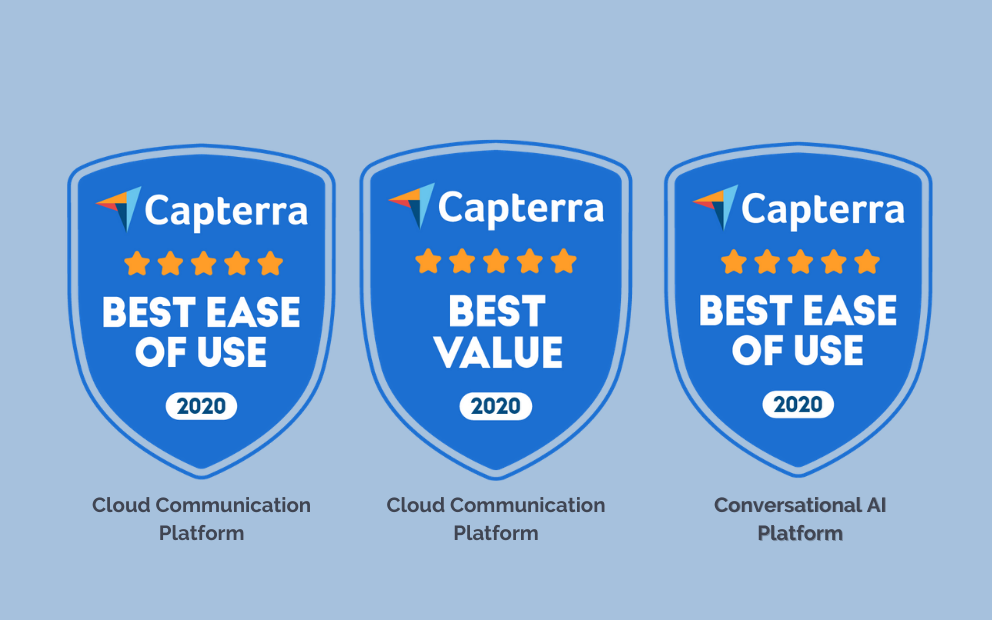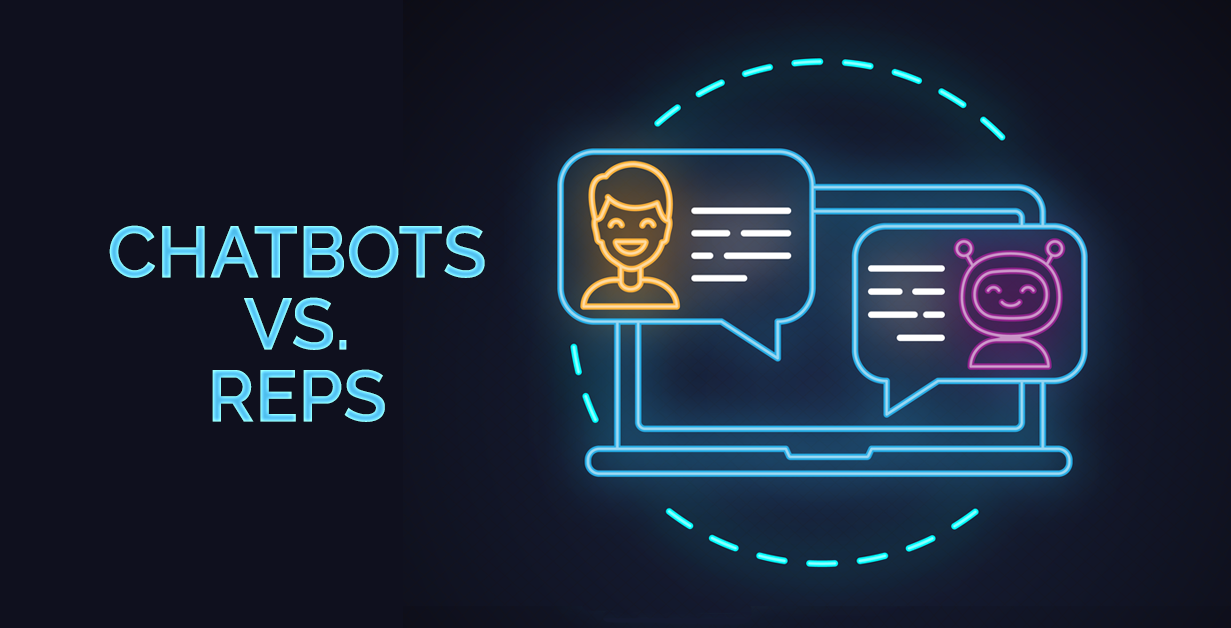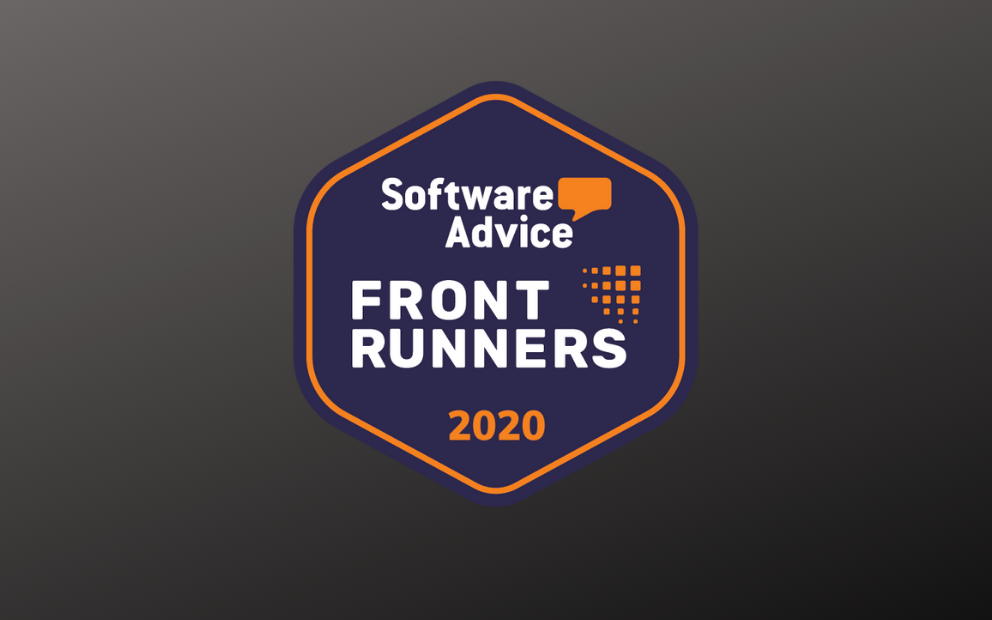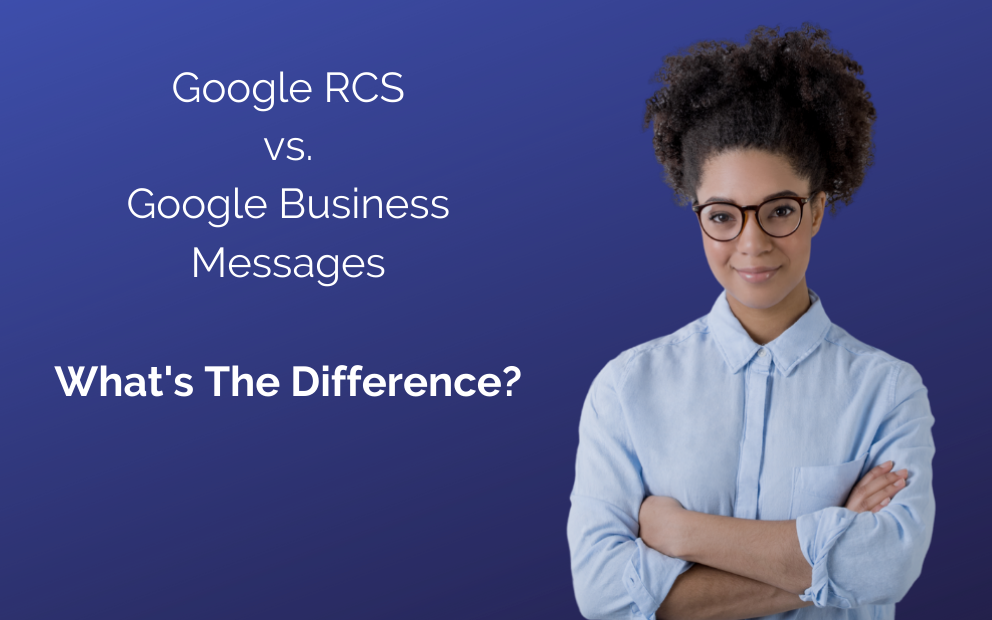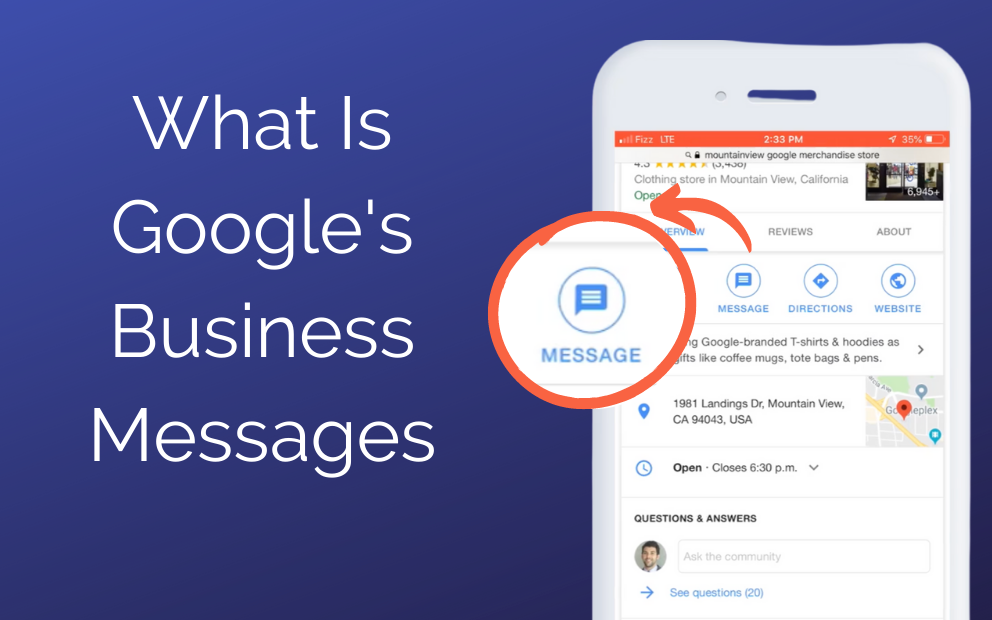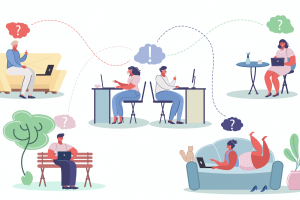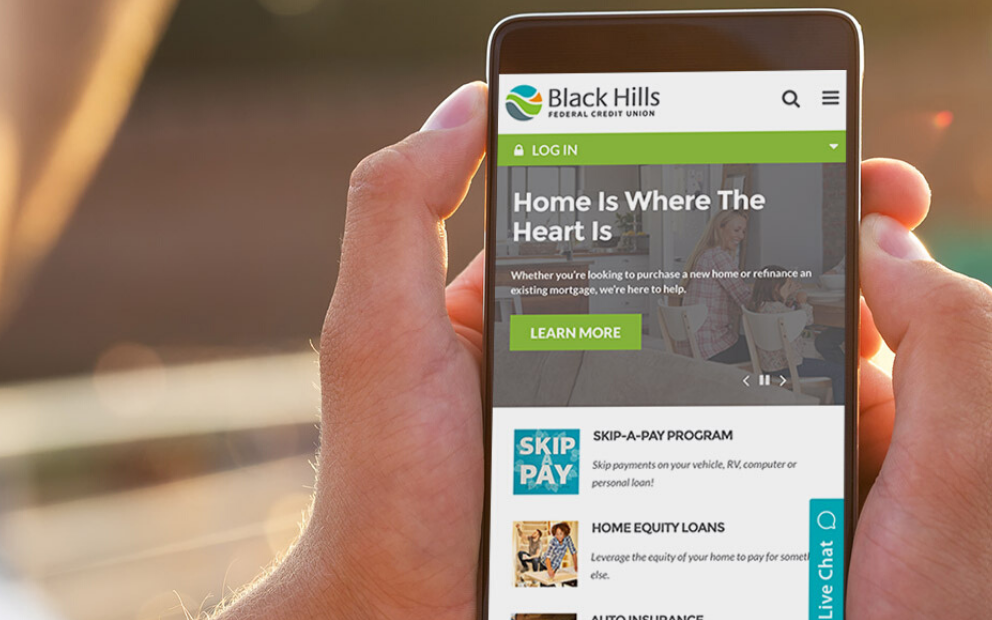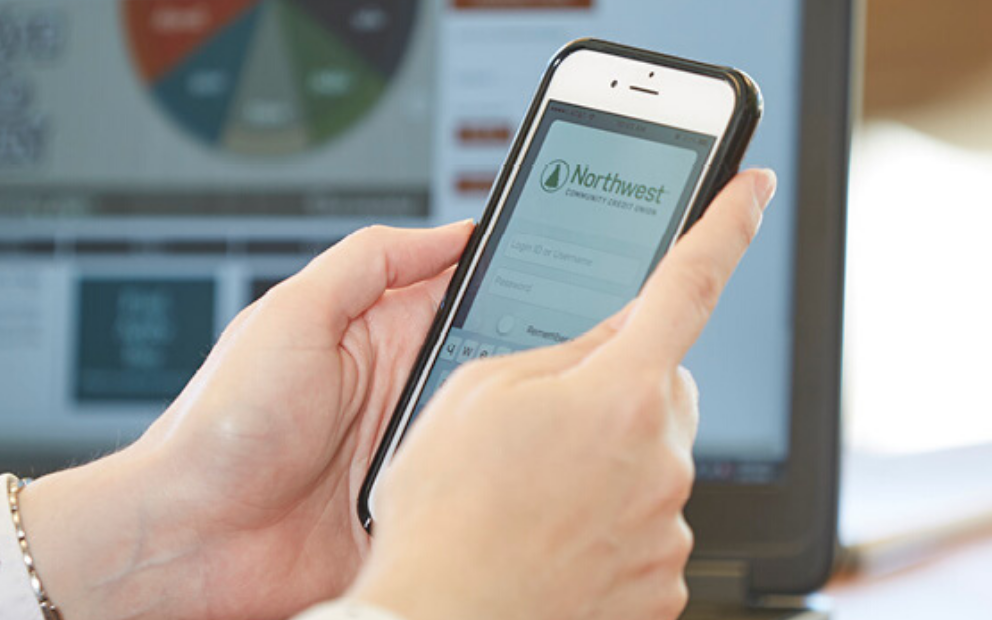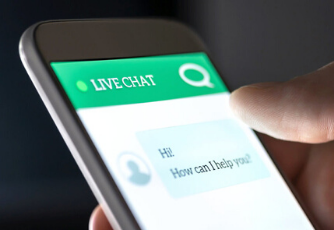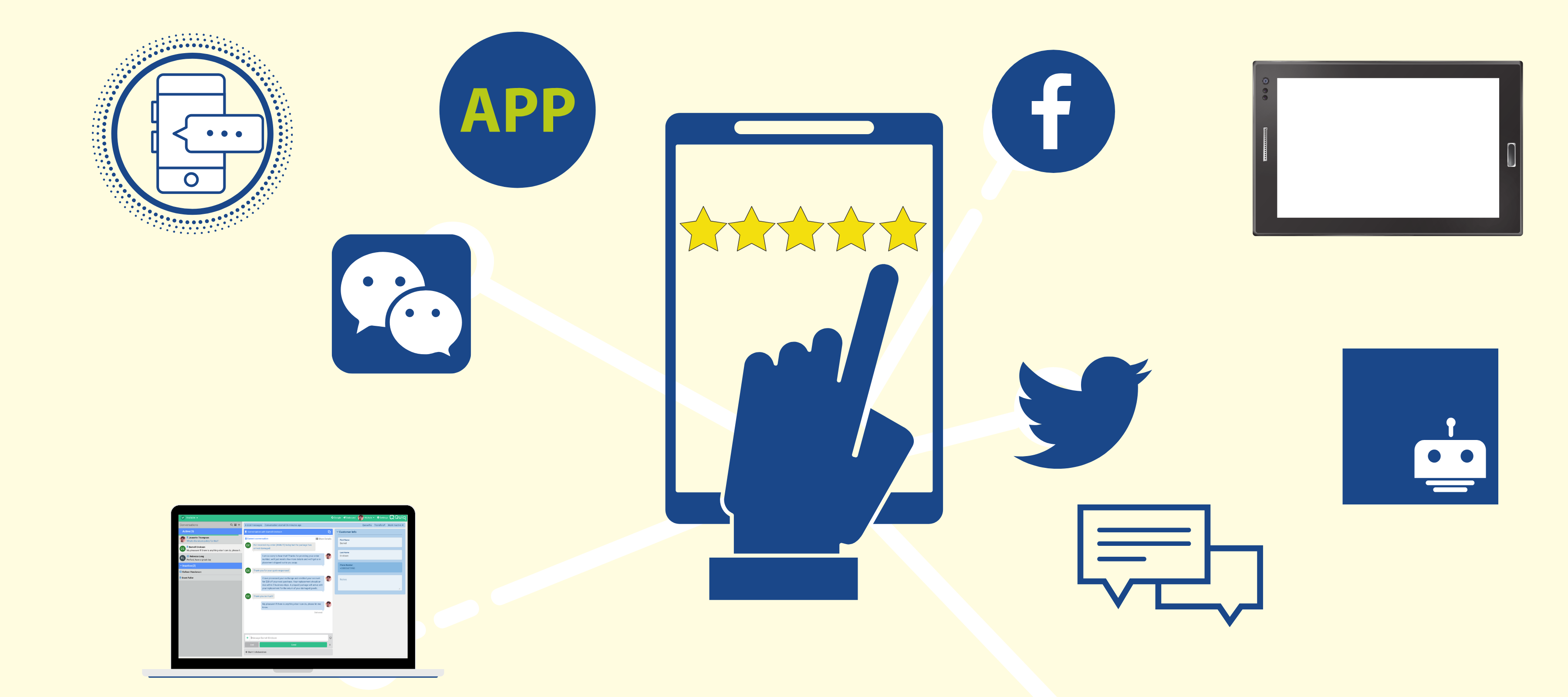Tag: chatbots
Quiq Earns 3 Capterra “Best” Badges
Provider of digital engagement solutions, Quiq is excited to announce we have earned three new badges from Capterra, one of the top software review sites in the world. Quiq was recognized within the Cloud Communication Platform category with “Best Ease of Use” and “Best Value” badges. The company was also recognized in the Conversational AI Platform category with the “Best Ease of Use” badge.
The Best badges aid in software research to help buyers make more informed decisions. Best badges are based on reviews spanning the Gartner Digital Markets network. The badges synthesize reviews to recognize the most highly-rated products in a given software category.
Why Quiq Has Been Recognized As The Best
Quiq’s recognition by Capterra in these categories originate from the company’s mission to help brands present their customers with consistently jaw-dropping customer experiences across business messaging, web chat, and with bots, the most popular channels that consumers care about. In order to help our clients deliver a great customer experience and realize significant productivity improvements, we focus on implementation and proven best practices.
Here’s what you can expect from working with Quiq:
- A focus on your objectives to ensure success right from the start
- A smooth implementation of Quiq as either a stand-alone product or as an integration into your existing systems.
- An intuitive design that’s requires almost no training
- Unlimited users so that everyone in your organization can use messaging
- A seamless integration of automation such as routing rules and chatbots across all of Quiq’s digital channels
- Robust reporting so that you can measure and manage the things that matter most
- A responsive team that is eager to help you over hurdles and guide you with best practices
How To Use Reviews In Your Software Purchase
Finding the right software can be tough. With so many choices and differences in features, it helps to get recommendations from other buyers. Reviews help throughout the purchase process. Read our customer reviews on Capterra to understand why top brands chose to work with Quiq and why they continue to be delighted with their decision.
Quiq’s team of conversation experts are ready to help you make an informed decision and choose the best software for your contact center. Schedule some time to discuss your current and future business needs today.
About Capterra’s Best Badges
The Best badge recipients are determined by the subjective opinions of individual end-user customers based on their own experiences, the number and timing of published reviews on Gartner’s digital sites (Capterra.com, SoftwareAdvice.com, and GetApp.com) and review ratings for a given product in the category, and are not intended in any way to represent the views of Gartner or its affiliates.
Gartner’s GetApp Names Quiq A Category Leader In Live Chat
2020 Category Leader for Live Chat
Quiq is pleased to announce that it was named a 2020 Category Leader for Live Chat by GetApp. Category Leaders are designed to help businesses evaluate which software products may be right for them.
Category Leaders are published on GetApp, a highly respected recommendation engine that companies rely on to make the right software choice. Category Leaders rank based on ratings submitted by verified users in five key areas:
- Ease of use
- Value for money
- Functionality
- Customer support and
- Likelihood to recommend
Quiq was named a category leader for Live Chat Software. Quiq scored an overall rating of 4.6 out of 5 based on 34 reviews.
“From the Admin side: excellent customer service, ease of implementation, and timeliness of requested actions. From the User side: extremely intuitive for agents, high customer satisfaction, and efficiency. Overall, Quiq is a forward-thinking platform that really understands customers’ needs both internally and externally.”
– Kim E. Apparel & Fashion
GetApp is a software review site that enables businesses to discover, compare, and choose the right business applications, ranging from live chat software to cloud-based messaging software. Software buyers can access customer reviews and product features to find the right software for their business.
Quiq is proud to receive this recognition which was based, in part, on the positive customer reviews received. If you’re exploring live chat options for your business, schedule some time to speak with one of our conversation experts.
Chatbots vs Sales Reps: Which is More Effective?
Automation and artificial intelligence are on the rise and many companies are finding ways to implement these new technologies to use to their advantage. Service isn’t the only department benefiting from the use of chatbots, marketing and sales have also been using them to gain an edge. With the use of artificial intelligence and chatbots, companies can more effectively lead customers through the sales funnel.
What is the impact for sales reps? As we’ll discuss in-depth in this article, chatbots and sales reps each excel in different situations and prove the benefits and effectiveness of working as a team.
What Can a Chatbot Do?
Chatbots are a mix of automation and artificial intelligence. They answer user queries through chat interfaces like text messaging, Facebook Messenger, and web chat on a business’ website. Chatbots are able to provide fast answers to common questions, and they’re proactive so customers can get help before they hit a snag. As bots continue to learn, they’re ability to preempt customer inquiries and offer more and more helpful solutions will only grow.
Chatbots are sometimes confused with live chats, but there’s a difference. In a live chat, there’s usually an actual person on the other end, while talking with a chatbot is essentially chatting with a robot.
Advantages of Using Chatbots
Using chatbots will offer your company many unique benefits that can help improve your business. For example, chatbots automatically capture and qualify leads on your website. If a consumer is looking for more product details or wants to inquire about pricing, a bot can capture their information and route to the appropriate agent queue. People are more apt to engage with chatbots when they know they can find what they are looking for more easily. Consumers are looking for fast answers and chatbots help them get on their way.
Chatbots are also designed to reduce administrative tasks so agents can spend more time answering the tough questions or giving extra special care to customers or prospects.
Disadvantages of Using Chatbots
One major disadvantage of using chatbots is that at first, they typically can only provide limited responses. Conversation rules determine what messages are sent in response and those can only be built over time. Although, it doesn’t take long before they are able to have much greater depth in contextual conversation.
While chatbots are gaining in artificial intelligence, today, they still have to be maintained and improved upon. It is important to not let your chatbot go stale to keep up with changes in the business and continue to improve customer engagements and enhance the experience.
Benefits of Using Sales Reps
Sales reps are essential to the process of bringing users further into the sales funnel and providing them with answers to higher-level questions about your company and its products and services. Context and emotional intelligence are crucial to meaningful conversations that will turn into sales, and the ability to emote and understand emotions is unique to your sales reps.
Each sales rep also brings their own unique personality to the exchange, which helps them form a personal connection with users that today is more difficult to achieve from a chatbot.
Disadvantages of Using Sales Reps
A significant disadvantage of using only sales reps is there are lots of engagements with customers that can be easily automated to help them more quickly. Administrative tasks take away time that could be spent having one-on-one interactions with customers to generate more sales.
How Can Both Be Used Collaboratively?
When it comes to a chatbot vs. a conversational agent, each has unique strengths that address the other’s weaknesses. When they’re used together, chatbots and sales reps can create an exceptional user experience that maximizes performance and increases sales.
Using Quiq’s chatbot feature will allow your call center to improve efficiency and reach optimal service rep effectiveness. For more information about our chatbot, contact us today to see a demo.
Gartner’s Software Advice Names Quiq A FrontRunner for Live Chat
Quiq is proud to announce that it has been named a FrontRunner for Live Chat by Software Advice. To earn an esteemed “FrontRunners” badge, a product must receive top user ratings and achieve high scores in functionality, ease of use, value for money, likelihood to recommend, and customer support.
The FrontRunners quadrant, powered by Gartner Methodology, provides a data-driven assessment of products in a particular software category. Published user reviews, public data sources, and data from technology vendors are used to determine which products offer the best in usability and customer satisfaction. Only products that earn top user ratings make the cut as FrontRunners.

Why Quiq Ranks High For Usability
The usability score is evenly weighted on two fronts: functionality, and ease of use. Quiq strives to make customer engagement between consumers and businesses easy and convenient, so usability is always a top priority.
Here are a few ways for companies to realize immediate value with Quiq’s live chat:
- Easy setup – We set our customers up for success right from the start by making implementation fast and friction-free.
- Pre-built integrations – We built seamless Salesforce, Oracle Service Cloud, Zendesk, Kustomer integrations, as well as promote an “API First” strategy, allowing Quiq to work in harmony with your existing systems.
- Intuitive design – The agent desktop is straightforward and easy to use, which makes training employees a “non-issue”.
- Informative dashboard – Managers have full visibility to reports and dashboards to display important agent, queue, and performance metrics.
There are plenty more features that make Quiq’s live chat solution a highly functional, easy solution for live chat. Learn more by heading over to our Quiq web chat page.
“Easy install process, great customer service from the Quiq staff,”
– Rachell M. Higher Education
Why Quiq Ranks High For Customer Satisfaction
The Customer Satisfaction score uses ratings on value for money, likelihood to recommend, and customer support. As a customer-centric organization, our entire team is dedicated to providing value to our clients throughout our partnership..
Our commitment to customer service means that we’re monitoring and responding to customer needs 24/7. With Quiq, you have a team of Account Representatives, Customer Success Managers, and Developers committed to your success.
Quiq is dedicated to giving our clients the most effective, easy-to-use tools for delivering jaw-dropping customer experiences. The acknowledgment from Software Advice is proof that the entire Quiq team is passionate about helping the company achieve that goal.
“Quiq is very receptive to feature requests and they work with you to make sure that you and your team are satisfied!”
– Heather M. Consumer Goods
The Difference between Google RCS Business Messaging and Google’s Business Messages
If you’re still wondering “What’s the difference between Google RCS and Business Messages?”, you’re not alone. You’ve probably heard a lot about the benefits such as the ability to send and receive longer messages, attach files, and send hi-res images. While there are similarities between the two, let’s dig into the differences.
The biggest difference between Google RCS Business Messaging and Google’s Business Messages is that “RCS” is actually a protocol adopted by the major telecommunication carriers and device manufacturers. It sets the standard of what rich messaging is. On the other hand, Google’s Business Messages is a mobile conversation channel that uses the RCS standard.
There are a few more nuances to examine. To understand the differences further, we’ll have to get into the details on each. Let’s dive in.

What is RCS Business Messaging
The standard for sending text messages began with SMS (Short Message Services) in the 90’s with 160 character limits sent over mobile networks. MMS or Multimedia Messaging Service introduced images and videos to messages, but SMS is still the most prevalent method. Rich Communication Services (RCS) is the next evolution of messaging.
Google RCS Business Messaging uses the RCS standard. RCS Business Messaging is Google’s managed platform that allows businesses to send rich messages between their business and a consumer’s phone. Brands can communicate with consumers through Messages, Google’s native messaging app, while using the range of rich media and Rich Conversations capabilities available with RCS.
Brands and consumers get a better messaging experience because of it. Take a look at just a few of the features consumers and brand enjoy:
Consumers:
- Trusted branding like logos and sender verification so that they can be sure they are talking to a representative from the respective brand
- Suggested replies, which are a set of short responses that consumers can use to reply to questions, help expedite conversations and guide consumers through choices
Brands:
- The ability to send outbound messages for promotional campaigns, proactive notifications, or to pass transaction details like shipping alerts
- Brands can integrate business systems such as a CRM or marketing automation to share notifications of real-time business actions with consumers on Google RCS Business Messaging
With Google’s RCS Business Messaging, brands engage with consumers through Messages, Google’s native messaging app, using rich media and the rich conversations capabilities available with RCS. This is really important to remember. Currently only Android users that are using Android Messages for their messaging application will experience RCS Business Messages.
Currently only Android users that are using Android Messages for their messaging application will experience RCS Business Messages.
Currently, access to the RCS Business Messaging program is only available through Google partners like Quiq. Our team would be happy to walk you through the registration process.
What is Google’s Business Messages
Business Messages is a mobile conversational channel that combines entry points on Google Maps, Search, and brand websites to create rich, asynchronous messaging experiences that delight customers and drive business results such as lower call volume, higher customer satisfaction, and increased conversion rates.
Consumers reach out to companies that use Google’s Business Messages for help via text instead of calling a phone number. Because of this, Business Messages is a great way to drive call deflection. Business Messages can tie into search results in multiple locations as shown in the screenshots:.
- Answer Card results – These results are one of Google’s featured snippets that are typically displayed in a box at the top of Google’s results page above the organic results, but below ads. The screenshot below shows the answer card results for the consumers search for “Neiman Marcus customer service”.
- Site Link results – These are the links that are shown below some of Google’s search results and are meant to help users navigate your site. The middle screenshot below displays results with sitelinks helping consumers find other areas of the Neiman Marcus site they may find interesting..
- Place Card results – These location based results provide more comprehensive information about a place in search results such as its complete address, phone number, user rating and reviews. The third screenshot shots Place Card results for Men’s Warehouse.

With this channel your business registers as an “Agent”. This is a separate registration than the RCS Business Messages registration. When a consumer messages your business, you are not given access to their phone number, you are given a unique identifier for the user and their display name used on their Android device. Because of this Business Messages has the following advantages:
- Because consumers are not messaging you from their phone number, there are no carriers and messaging app restrictions. Virtually all Android users can use this technology.
- Messages are encrypted.
- ALL messages, images and rich messages, are branded and verified, creating a high trust channel
It’s also important to remember that these messages won’t live in the Messages app like RCS Business Messages. These messages persist in Google Maps for Place Card results and within the Android device’s notifications area for Answer Card and Sitelinks results.
A Side By Side Comparison Of Google RCS And Google’s Business Messages
Both RCS Business Messages and Google’s Business Messages provide consumers and brands with an elevated experience. Whether your focus is driving “unforgettable” conversations or simply providing quick transactions, these branded, media-rich messaging experiences can help you get there.
Still a little confused? Here’s a chart comparing the two side by side. As you can see, both have their advantages and limitations. The good news is that companies don’t have to choose between one or the other. One of our conversation experts can help you decide which program works best for you or if you should apply for both depending on your unique business needs.

As a Google program partner, Quiq can help you get started with either or both programs. We handle the registration process for you. Once we get started, you’ll work with the Quiq Customer Success team to optimize messaging for your organization.
Quiq’s messaging platform supports Google, Facebook, live chat and more. Our platform brings all of your digital channels together into one intuitive agent desktop. Quiq has worked with companies from large enterprises to mid-sized companies to implement messaging across all of our supported channels and automating workflows for your entire organization.
Ready to leverage the power of Google to help your business grow? Schedule a call with one of our conversation experts today.
What is Google’s Business Messages

When consumers have questions, they turn to Google for answers. When consumers want quick and convenient conversations, they turn to messaging. So, what if I told you there was a way to combine the power of Google’s search with the convenience of messaging to make it super easy for your customers to find and engage with you?
Learn More About the End of Google Business Messages
Well there is. Google’s Business Messages provides brands a comprehensive messaging solution across Android devices through Google search and Maps.
DEFINITION: Google’s Business Messages is a mobile conversational channel that combines entry points on Google Maps, Search, and brand websites to create rich, asynchronous messaging experiences.
Let’s take a closer look at Google’s Business Messages and all of the great features that make this channel a must have for every company.
How Your Customers Will Use Google Business Messages
Google Search and Google Maps are two features that your current and potential customers use on their phones all the time. Consider these following stats:
- 35% of product searches start on Google. (eMarketer), and
- 34% of “near me” searches done via desktop and tablets result in store visits. (HubSpot)
With Google’s Business Messages, customers can click the “Message” button presented within the search results to start a conversation with your company.

If you’re curious about what the experience will be like for your customers, you can try out Business Messages for yourself. If you have an Android device, you’ll want to make sure you have RCS enabled on your phone. Once you do, do a Google search for “Quiq Bozeman”. You’ll find the “Message” button in the overview section. Click and start a conversation with us.
The conversation will start with a greeting from our Quiq HQ Bot. Feel free to ask a question or send an emoji. You should expect one of our conversation experts to be with you quiq-ly.
Features of Google’s Business Messages
Business Messages isn’t just for brands that want to be discovered. Here’s an example of a well known brand using Business Messages to deliver a better experience for their customer.
Luxury department store Neiman Marcus is a juggernaut in retail and customer experience circles. The retailer worked with Quiq to implement Business Messages and elevate their customer’s shopping experience.
When Neiman’s organic search result is shown, “Message with a live agent” is presented at the bottom along with the company’s typical response time. When clicked, customers are then taken to their messaging app to continue the conversation. But that’s not the end of the story, in fact, it’s where the benefits begin.

Within the messaging conversation, consumers are able to shop, ask questions, and complete secure payment transactions. Customers are also able to easily get updates such as order tracking, refunds, and handle service inquiries.
Google’s Business Messages enhances customer care, with rich features like:
- product photos and carousels that expand the conversation to drive purchasing, scheduling, and upselling,
- suggested replies that enable consumers to respond with just a tap of a button,
- typing indicators, delivery confirmations and read receipts that keep conversations moving along,
- the ability to send and receive emojis, hi-res images, and videos ensures that the conversation is personalized.
Since messaging is the channel preferred by consumers, businesses will see more of their customers turn to messaging instead of calling their contact center for pre-sales service and post-sales support. Business Messages integrates directly with a company’s digital customer service platform, like Quiq, so handling these conversations happen in one, easy-to-manage agent desktop.
Don’t Wait To Get Started With Business Messaging
Quiq is part of Google’s partner program for Business Messages which enables us to onboard brands, influence the roadmap and standards, and be among the first to offer our customers an upgraded messaging experience through Google Search and Maps.
We’re ready to help you get started with Google’s Business Messaging and can help you get registered, implement, and deploy Business Messaging for your business. Ready to explore Google’s Business Messages and Quiq? Schedule some time to talk to one of our conversation experts today.
5 Tips To Enhance eCommerce Customer Service
For many consumers, purchasing a product is about more than just the product itself. Consumer demands continually grow as they prefer faster and higher quality customer service from brands. That’s why many businesses today are choosing to implement a more effective online customer service experience strategy. eCommerce businesses are ramping up their digital customer service to make sure their customers keep coming back to them instead of exploring other options.
How to Improve Your eCommerce Customer Service Strategy
Online shoppers want instant replies and easy answers. eTailers that are catering to their customers in these ways will benefit from consistently refining their service, sales, and marketing communication strategies. Five common ways to improve eCommerce customer service include the use of the following communication channels and automation.
1. Text Messaging
Text messaging for customer service is fast and convenient making it easy for eCommerce companies to connect with consumers to assist in shopping cart conversions and follow-up with pertinent order information. This shopper-friendly channel allows consumers to be on-the-go, and in this busy world, text messaging has become the channel of choice for receiving information, solving problems, and answering urgent questions.
Consumers prefer text messaging because they are able to start the messaging conversation while on a mobile eCommerce site and finish them at their convenience while moving about in their normal life. Imagine an online shopper sending a message to a brand requesting help getting the details of their online shopping cart correct, but then needing to get on with their busy day. The agent could build and confirm the order and send a link back to the consumer via SMS. The consumer can then click the link that would send them to a secure mobile web page where they can confirm the contents of their shopping cart and complete the purchase securely.
An asynchronous conversation like this allows for eCommerce businesses to move at the speed and cadence of their customers, making for better customer experiences and more modern shopping experiences.
2. Web Chat
When it comes to eCommerce and enabling customers with a fast and easy way to get in touch, web chat is the most obvious choice. Customers on your website may have a multitude of options for finding answers, like an FAQ page, sending an email, or calling, but none help customers as fast as the omnipresent option of web chat, typically presented in the lower right corner of your website.
Online shoppers expect fast answers when they are adding items to their shopping cart or in the process of completing a purchase, similar to when they are shopping in-store. Without web chat, customers may save their purchase for another day, or find what they are looking for elsewhere altogether. This is why the messaging channel is a critical part of any eCommerce website to ensure customers find what they are looking for and are being helped at every point in the customer journey, from product recommendations to purchase confirmations, and being available for any follow-up questions. Never miss a chance to answer customer questions or assist in a sale.
3. Social Media Messaging
The market for customer conversations has grown beyond websites and call centers to include social media platforms, which is why more than 90% of businesses today have some form of social media presence. Consumers have not limited themselves to engaging with and conversing about brands to only in-person interactions and are now expressing themselves in more amplified ways across platforms like Facebook and Twitter.
eCommerce companies can engage with their customers across these social media platforms to build advocacy and highlight their brand in the broader marketplace. These platforms offer more opportunities to connect with consumers in direct messages to answer questions and be a part of the conversation. Consumers are becoming increasingly agnostic to where they expect brands to provide support, and social media is an example of where conversations are happening and where brands need to ensure they are part of them.
4. Outbound Messaging
Online retailers reap huge rewards by keeping their customers in-the-know. A prime example is regarding order status. Customers feel better when they know what to expect, like if their package may be late or even to hear it’s arriving early. Never miss an opportunity to delight customers.
Outbound text messaging is an incredibly effective way to communicate with consumers, particularly if you consider they are reading texts at a rate of 98%. With this much attention being paid to text messages, it becomes an great opportunity to entice them with upcoming specials or promotional codes.
The best solutions don’t stop at just sending outbound messages. Businesses should also enable 2-way conversations so consumers can respond and have agents or bots standing by to help answer any questions.
5. Chatbots
Retailers and eCommerce companies are increasingly leaning on the efficiency and cost savings that chatbots provide. Chatbots are always available to answer pre- or post-sales questions, assist shoppers with their selections, provide order and shipping information, and answer common questions.
Chatbots are truly revolutionizing eCommerce to encourage more sales and are becoming a key part of customer service strategies to improve customer satisfaction. Research indicates that the chatbot market will grow to 9.4 billion by 2024 at a growth rate of almost 30%, which means it’s predicted to become mainstream in the coming years.
Chatbots are increasingly important for companies with high volumes of traffic to be able to deflect questions that can be answered with an automated response, to resolve issues more quickly. This is critical in assisting agents and routing the most high-value conversations from consumers for extra-special customer care.
Contact Us for a Demo
You can improve eCommerce customer service for your business in a number of ways, from implementing business messaging software to including automation with bots into your customer service strategy. Whatever your company’s goals, Quiq is here to help you find the ultimate online customer service solution. Contact us today to request a demo.
Black Hills Federal Credit Union: Serving Members Goes Mobile
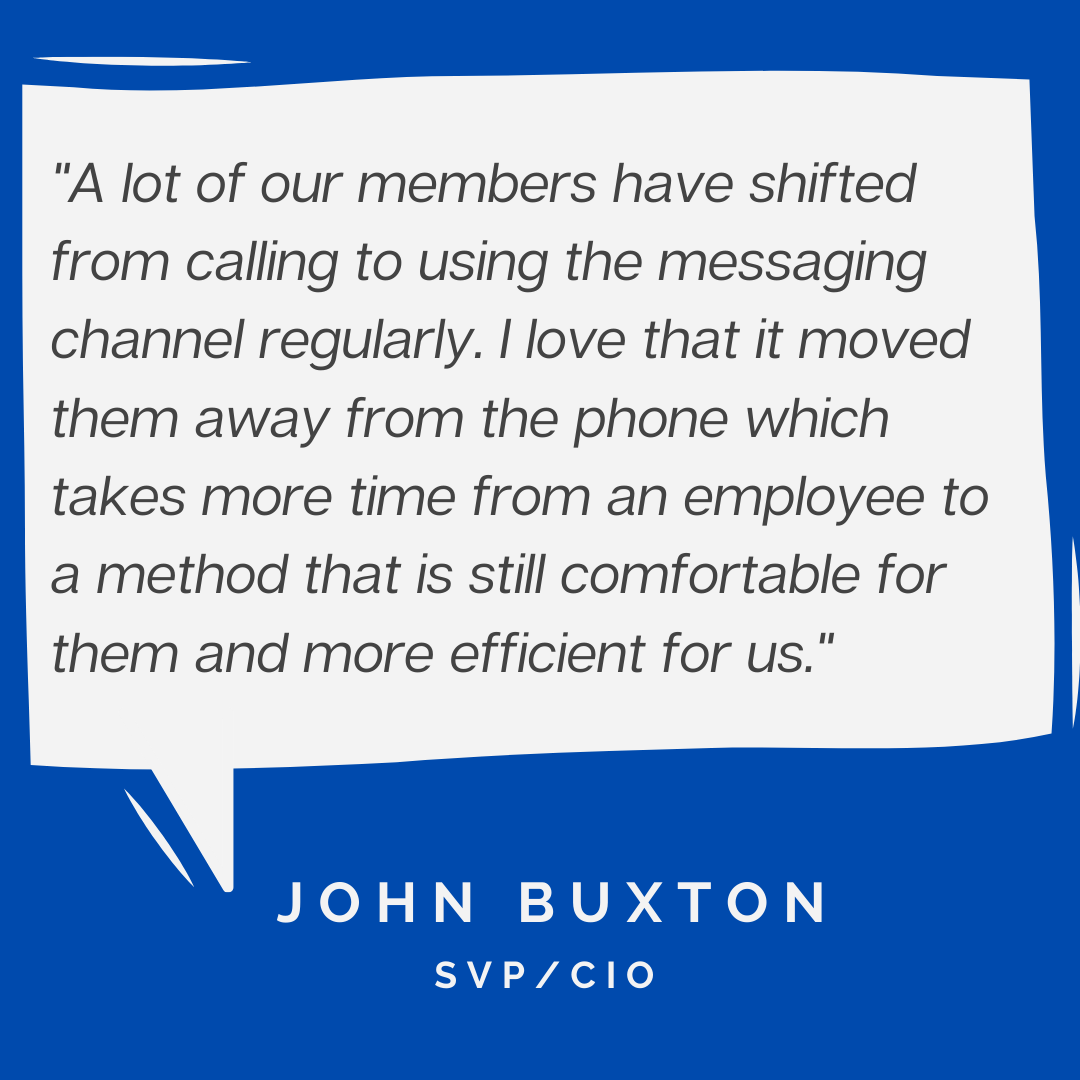 Black Hills Federal Credit Union (BHFCU) is proud to be a part of the community they serve. They help members who are spread out across SouthDakota buy their first home, their first car, that second home, and even start businesses.
Black Hills Federal Credit Union (BHFCU) is proud to be a part of the community they serve. They help members who are spread out across SouthDakota buy their first home, their first car, that second home, and even start businesses.
They know that no two members are alike, but they’re also certain that there’s some common ground for all of their 75,000 members.The need for convenient and secure ways to engage with the credit union was one thing all members wanted.
Free online bill payment, mobile check deposits, and Apple Pay are a few of the ways the credit union has made managing money from anywhere possible. Now messaging is part of that list of digital conveniences helping BHFCU live up to their mission of “We Improve Lives”.
Why Black Hills Federal Credit Union Chose Messaging
BHFCU wanted to provide a communication channel that members preferred. Text messaging was an obvious choice since mobile banking has grown steadily over the years. Statista reports that over three quarters of Americans used a mobile device the last time they checked their account balance. Since text messages also have a 98% open rate and a 209% higher response rate than traditional methods of engagement like phone and email, the messaging channel held the promise of reaching members with higher success rates since many frequently wouldn’t answer calls from the credit union or see an email as quickly.
Prior to working with Quiq, BHFCU handled questions ranging from balance inquiries, transaction info, name changes, adding joint members, disputes, and general account questions through phone, email, and social media platforms. Working with Quiq provided a way to not only add chat and text messaging, but enabled employees to gain efficiency by consolidating channels into a single platform.
Going Live With Messaging
 The team at Black Hills decided to take things slowly to get a feel of the new channel and implemented Quiq for inbound texts only. Getting started with Quiq was straightforward and happened quickly. In the words of SVP/CIO John Buxton, “Implementation was super smooth.” The credit union has since added web chat, outbound messaging, and integrated messaging with their IVR system.
The team at Black Hills decided to take things slowly to get a feel of the new channel and implemented Quiq for inbound texts only. Getting started with Quiq was straightforward and happened quickly. In the words of SVP/CIO John Buxton, “Implementation was super smooth.” The credit union has since added web chat, outbound messaging, and integrated messaging with their IVR system.
Contact center agents were provided hands-on training and practiced texting with each other before going live. Black Hills used their member newsletter, Facebook, email, and website notifications to promote messaging to their members.
There are currently 35 total employees using Quiq. The credit union has approximately 18 contact center agents, with one agent solely dedicated to handling chats and texts, in addition to employees in the mortgage lending and card services departments. The team plans to continue adding users and are focusing on collections and consumer lending next.
Improving The Member And Employee Experience
Members have eagerly adopted messaging. Not only has it made banking with Black Hills Credit Union more convenient, it also saves them time and money. The credit union doesn’t have to charge members any fees to get help on the messaging channel. Many members text to receive their balances or to initiate transfers for free with just a few taps on their phone.
The Black Hills team has been surprised how many members have become regulars to the messaging channel and the overall response rate they’ve seen. When reaching out to update addresses, agents offered text as an option with higher than average responses. “I feel like many of those people wouldn’t have called back or responded to a letter. The text was easy for them, and it worked well. I thought that was awesome!” says John.
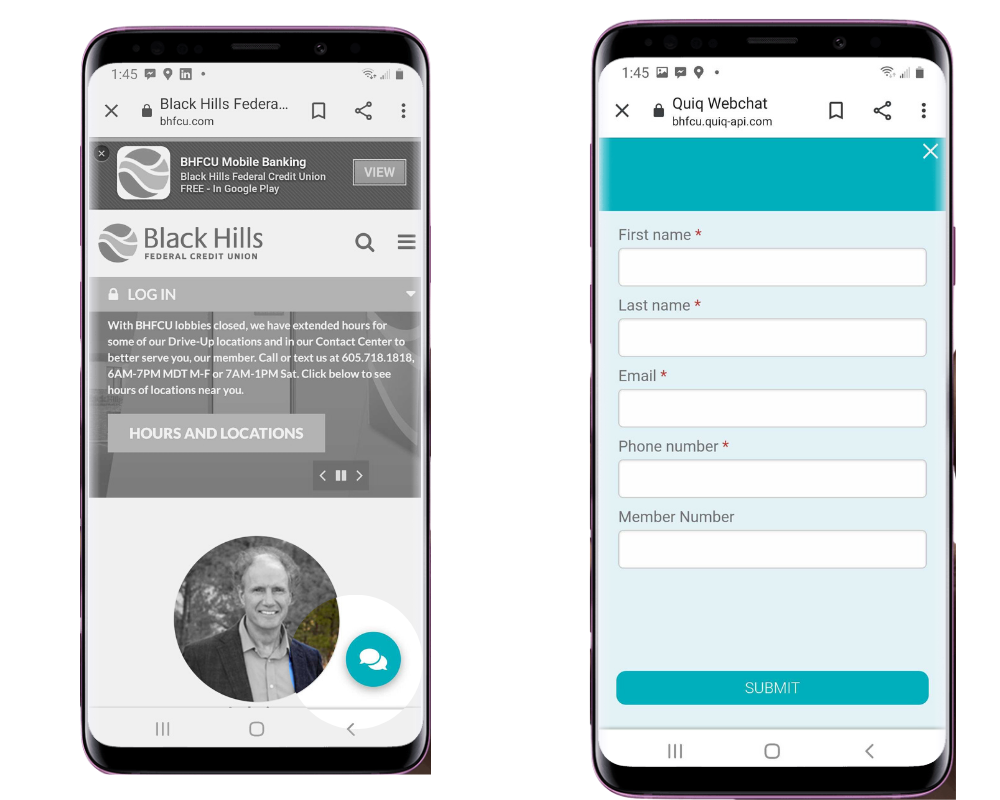
What’s Next For Messaging At Black Hills Federal Credit Union
The popularity of the channel among agents has Black Hills FCU taking a look at how to more evenly distribute the messages among agents. Currently, the team is using a round robin system, but feels they could improve that process so that more agents have the chance to handle text inquiries.

BHFCU sees a plethora of opportunities to use Quiq in the future. BHFCU developers recently utilized the APIs to create a secure authentication snippet to identify members with a pre-existing password that is stored on the core banking system. Future releases will add more options integrated with other systems, such as online banking credentials.
This summer, the credit union will also build extensibility with an enterprise preference management system to retrieve and maintain opt-ins required by TCPA. By end of the year, the team is planning to create bot-based workflows to manage common inquiries from members. Having authentication capabilities in place will allow the credit union to potentially realize additional cost savings.
Northwest Community Credit Union Blazes New Trail With Messaging
Lines wrapped around branch locations that were three lanes deep and 45 minute wait times on the phone. That’s what 108,000 members at Oregon-based Northwest Community Credit Union experienced after branches closed due to COVID-19. Messaging instantly became a valuable channel that enabled members to get a response in 1.5 minutes or less.
Even before the pandemic, the team at NWCU knew that messaging was their next frontier. Members had started to request the ability to communicate with their loan officers via text. The team set their focus on making engagement more convenient for members on their preferred channel.
Messaging Was The Silver Lining
Northwest Community partnered with Quiq in Feb of 2020 with plans to start with outbound messaging for the member solutions and lending teams in early 2020. That was before COVID-19 required the 14-branch credit union to evacuate buildings and close branches. The challenges imposed by the pandemic drastically changed the roadmap, shortening implementation to days instead of months, and reshuffling priorities.
When the team went live with Quiq in the first week of April, 2020, the world was well into the pandemic. The contact center was overwhelmed with flooded phone lines and crowded inboxes. Instead of introducing another channel to the contact center, NWCU pulled together a team composed of branch employees to manage messaging.
 The intuitive nature of texting and Quiq’s interface made employee training easy, providing the flexibility the organization needed during the staffing turmoil of the pandemic. “The beauty is that it’s so easy we’ve been able to have employees from all over the organization, including many employees who have never talked to members, using the channel, supporting them, and it’s just been seamless, so that’s been really great. It’s been the silver lining in rolling out something in the midst of COVID.” says April Cooper, Director of Digital Experience at Northwest Community Credit Union.
The intuitive nature of texting and Quiq’s interface made employee training easy, providing the flexibility the organization needed during the staffing turmoil of the pandemic. “The beauty is that it’s so easy we’ve been able to have employees from all over the organization, including many employees who have never talked to members, using the channel, supporting them, and it’s just been seamless, so that’s been really great. It’s been the silver lining in rolling out something in the midst of COVID.” says April Cooper, Director of Digital Experience at Northwest Community Credit Union.
When a live chat is initiated, members are greeted by a chatbot, which presents a menu of topics members are most interested. Options, such as branch availability, scheduling appointments with a branch, processing a skip payment, checking the status of stimulus checks or Payment Protection Program loans, provide members the information they need without having to call in or speak to a human.
Increased Productivity and Beyond With Business Messaging
Northwest Community acknowledges that they’re still pretty new with the channel but considers it a success. Not only were they able to roll out the channel quickly and include a bot, members love it, and the credit union has seen immediate efficiencies. In fact, 1 agent is handling the same number of messaging conversations as 3 FTEs would handle over the phone.
Normally human agents handle as many as 1500 to 1800 calls a month or 60 to 80 calls a day. With messaging, 1 agent is handling conversation volumes comparable to 3 phone agents.
“Implementing messaging was a real moral boost for us” says April. “ It gave all of us a chance to say, ‘Yes we’re in this. We’re closing our branches, but look at what we have to support you.’” April says that managing the messaging channel has now become a coveted position in the contact center as employees prefer the channel over the phone.
Match Your Members Changing Needs With Bots
As branches start to open, the information that members need will change. When they do, NWCU employees will be able to quickly and easily update the bot to reflect those needs within Quiq’s bot designer. The credit union has already had some experience with this.

Shortly after opening the messaging channel, the credit union began to receive hundreds of inquiries about the status of stimulus checks through the messaging channel. Due to some Goggle tagging, the credit union had become the top search result for a lot of non-members across the country who had questions on their stimulus check, not realizing they were contacting a credit union in Oregon.
Thankfully, the credit union was able to quickly insert logic into the bot to filter out those conversations. If the visitor chooses “Stimulus Check” from the menu of options, they are now asked if they are a member or not. If not, they are redirected to the IRS website. The credit union happily saw a 50% drop in these inadvertent messages after implementing this change. April says, “We’re able to learn on the fly and update our bot. Right now, our bot is still pretty simple, but this just shows how you can iterate and add additional layers of logic.
What’s next
Northwest Community still has a lot of plans for the messaging channel in the near future. Their first priority is to move management of the channel from the team of branch employees to the contact center and to entrust that team to monitor and measure the channel.
Soon, the collection team will use text messaging for payment reminders and enable the credit union to move away from the calls the contact center team would make to notify members when their payment was 10 days late. The team also plans to embed a secure link in the text so that members can get the information they need and take action to securely a payment.
In the future, expect to see the Northwest Community Credit Union leverage messaging to make banking more convenient for members with features like integration with their IVR so members can dynamically shift to a text message instead of waiting on hold. Plans are in place to roll the channel out to the lending team who will use messaging to schedule loan signing appointments or document collection notices.
The credit union is proud to say that “‘Uncommon’ is a way of life for Northwest Community Credit Union”. Lucky for the employees and members that they’ve taken an uncommon way to serve their members and community with messaging that helps everyone thrive.
How Call Centers are Becoming “Text Centers:” Text Messaging for Customer Service
Internet and mobile technology have fundamentally changed how business is done. With more people working from home and consumers spending increasing amounts of time on their mobile devices, businesses are having to adjust to meet technological advancements and new consumer preferences. There was a time when call centers only handled phone calls from customers. As customers have become increasingly digital, companies must find more efficient and effective ways to communicate with their customers.
Today, more than ever before, customer service has become one of the most important functions of the overall customer experience, and businesses are focusing on implementing personalized solutions rather than simply selling products. As a result, call centers have undergone a digital transformation — one that embraces the power of text messaging.
The Industry Follows Customer Preferences
Statistics show that in the United States alone, the average person sends and receives about 32 texts per day. What does this mean? In short, it means people like to text because it is easy and convenient. This provides the ideal opportunity to implement a digital customer service solution that supports messaging.
Today’s customer service is all about making the consumer experience as pleasant, personalized, and hassle-free as possible. Text messaging allows consumers to send questions and receive answers almost instantly. Better still is consumers get to drive the pace of the conversation, whether they are on-the-go or sitting on the couch, they can respond when it’s convenient for them, making text messaging the preferred method of communication over the phone for a vast majority of consumers.
Improved Satisfaction With Personalized Service and Dynamic Solutions
The issue with phone calls is they are a hassle for customers. that they tend to create an extra hassle for customers. Phone calls are a hassle because too often, they require the customer to sit on hold, repeat themselves, and interrupt their busy, on-the-go lives to have a voice conversation that can sometimes be hard to hear or understand. On the other hand, texting is fast and easy, with conversations capable of being on-the-go, and are aptly suited for our busy, digital lifestyles.
That’s why many companies are now converting their call centers into innovative digital centers. With messaging, businesses are providing customers solutions for resolving issues more quickly and in more engaging ways, like with the use of photos and videos, or even by expressing emotion with emojis ? . Messaging is suited for every kind of inquiry, and can even respond to seemingly complicated questions that include:
- Replacement product options
- Troubleshooting guide links
- Important documents or disclosures
Chatbots Help Improve Messaging Efficiency
While human-to-human correspondence is necessary at times, many of the most frequently asked issues can be easily managed by chatbots. Chatbots can help save time and resources, freeing agents up for more complex or higher priority concerns.
Digital transformation and customer experience are culminating with the advancement of chatbot technology being sophisticated enough that AI bots are having high-quality, human-like conversations with customers. With chatbots, consumers can get the information they are looking for much more quickly, reducing the need for phone calls and face-to-face interactions.
Call Centers Digital Transformation
While phone calls can be helpful in certain situations, they limit you and your customer to a single platform of communication. Messaging can be used across apps, social media, mobile devices, and more. This allows businesses to stay in contact with customers 24/7.
When customers have a quick question, they want fast answers, without any hassle. Texting with customer service is so easy, even grandpa knows how to do it. Text messaging for customer service is solving problems faster and with greater convenience for customers and agents.
Contact Us Today About Our Solutions
The importance of technology in customer service has become more important than ever as call centers steer away from single-channel communication. To learn more about how text messaging will enhance your customer service, request a demo today.
These Chatbots Are Helping Brands Respond to Covid-19 Queries
Government Technology: Governments Get Creative to Adapt to Coronavirus Reality
Quiq’s New Product Announcement: Quiq IQ
City of Knoxville deploys a web and SMS chatbot
Quiq’s New Product Announcement: Quiq IQ
How Stio Geared Up For Growth
Since opening its doors in 2012, Stio has embraced a direct-to-consumer model selling high-quality, active apparel for outdoor enthusiasts online and in-store. Clearly, the market has embraced them right back, experiencing rapid growth, especially in eCommerce which makes up 75% of the company’s revenue.
The mountain lifestyle brand, headquartered in Jackson Hole, Wyoming realized that it had to scale its digital customer experience to keep up with that growth. The company looked for technology that was just as adaptable and functional as their gear, turning to Quiq’s messaging, web chat, and bot platform for support.
The Good Problem of Growth
 When Kim Essensa, Stio’s Customer Experience Manager, joined the company in June of 2018, Stio had been experiencing annual growth rates of 52 percent. In the second quarter of 2018, Stio’s growth accelerated to an impressive 70% year over year.
When Kim Essensa, Stio’s Customer Experience Manager, joined the company in June of 2018, Stio had been experiencing annual growth rates of 52 percent. In the second quarter of 2018, Stio’s growth accelerated to an impressive 70% year over year.
That kind of growth comes with a few growing pains, especially in a contact center of 7. Based on previous experience in both her personal and professional life, Kim felt that live chat could help alleviate some of the load. The company already had a simple version of live chat available on their website but hadn’t turned it on. Her instincts were right. Turning on web chat helped the contact center feel an immediate relief.
Kim knew that text messaging was the next natural progression for engagement with consumers. While she had experience with other vendors like Live Chat, Olark, and Boldchat, she knew that having SMS and text messaging were key to take the company to the next level. Kim had used Quiq at her previous employer and evaluated it for Stio, knowing that it was going to have to make an impact on their efficiency, while working with their current systems.
“A few other programs were vetted. The relationship I had with Quiq before and knowing how responsive everyone is there, especially with tech issues, is what made Quiq stand out for me. When something is not working, you just need it fixed.”
~Kim Essensa, Stio
Quiq fit with the vision of where Stio wanted their contact center to be and the company went live with Quiq’s web chat on October 1. Implementation was short and successful, and employees only had to receive a small amount of training to get started,
“The platform is so intuitive and easy to use that the amount of training it takes to give it to my staff was super minimal,” says Kim. Having Quiq in place with a trained and ready staff was crucial since Q4 was looming on the horizon and like other retailers, the holiday season would make up a good portion of the company’s annual revenue.
Improving Efficiency
Before the holidays, Stio onboarded an after hours contact center to handle chat when the in-house team was offline. The after-hours answering service has been able to take some of the pressure off of Stio’s team during business hours as well, easily managing chat on Quiq’s messaging platform with very little training or day to day management from Kim and her team.
The increase in productivity helped employees and customers over the holiday season. Kim puts it this way, “Last year we were leaving the office with 300 emails in the inbox. This year we’re leaving with like 30.” After the holidays, Stio turned on text messaging and saw call volumes drop by 9%.

“Agents love Quiq. It’s just intuitive and super easy to use.”
~Kim Essensa, Stio
Now, Stio’s agents handle inbound messages from SMS, web chat, and Facebook Messenger all within Quiq’s intelligent workspace. Questions are typically focused on orders, with inquiries around shipping status or price adjustments. Now, if a customer just placed an order and the final cost didn’t reflect the promo code entered, they don’t have to call in and wait on hold for help. Now, they can send a text and get a faster response, since Stio’s agents can handle multiple conversations simultaneously.
Bots

In 2019, Stio took another step toward more efficient operations. Stio was one of the first companies to embrace Quiq’s bots across their messaging channels. Kim worked with the Quiq team to scope out what the Stio bot experience should be. It was important for Kim to keep the bot language short, simple, and casual, so it would feel like consumers are engaging with a human. It was also important to give customers easy access to a human agent whenever they wanted . Within a few days, the bot was up and running on the site.
Stio saw immediate results from implementing bots. The company, which drops 1.2 million catalogs for the holidays, used to take requests from customers who wished to be removed from the physical mailer. Today, a bot does it all on behalf of the agents- from beginning to end. During the first two weeks after implementing this single bot, Kim saved 83 precious agent hours on the catalog process alone. Agents can now concentrate on helping customers find the gear they want instead of managing catalog removals.
Quiq’s Shopify Integration
Stio recently integrated Quiq Messaging with their Shopify account. This integration gives agents incredible visibility into what the consumer is doing. They can see which web page the customer is looking at and what’s in their cart in real-time. According to Essensa, this has drastically reduced the time it takes agents to collect that information from customers and makes the experience smoother and faster for customers.
Stio is focused on keeping their agents available for customers who need human attention. That’s why they’ve introduced bots. When a customer uses messaging, a bot will collect core information from customers and take action on that information, sending the conversation to the best-suited human agent.

Kim believes the integration of Quiq and Shopify will increase overall cart value and conversions because agents will be better equipped with the information they need to close the transaction with the customer.
What’s in Store For Messaging
Stio is approaching conversational commerce from a very personal level and they are using technology to help “For us, it’s that natural conversation between the customer and the agent. We really want the customer to feel at home with Stio, like they’re talking to their best friend who just recommended the best ski kit in the world. We really try to make it a personal experience.” states Kim.
Stio continues to look for ways to make their customers experience more fluid and personal. “From the epic to every day”, that’s the mantra that inspires the team at Stio to create gear known for technical performance, quality, and versatility. Leave it to them to bring that same ingenuity to their customer experience with Quiq’s messaging platform.
Let’s put technology to work for you in your company to streamline workflows, increase efficiency, and deliver a seamless customer experience. Schedule a demo to discuss messaging and how Quiq can work with your company’s unique processes and systems.
How Higher Ed Can Manage Coronavirus Communications
The COVID-19/coronavirus has caused many universities to cancel lectures, extra-curricular activities, and large gatherings. Many are switching to online classes as a precaution to stop the spread of the virus.
Virtual classrooms have been changing mainstream education for some time, but the change has been evolutionary. COVID-19 has caused massive disruption forcing colleges and universities to quickly move from traditional education and brace themselves for the transition to virtual classrooms.
Many institutions are experiencing a flood of phone calls as parents and students seek information about campus operations, as well as COVID-19 updates. In this article, we’ll show you how digital technology helps higher education by taking the burden off of their switchboard and providing real-time information that emails and website updates can’t.
Messaging for Higher Education
The use of messaging as a way to quickly connect with students and parents isn’t a new concept. Higher Education Institutions like Texas A& M implemented messaging well before the COVID-19 pandemic to increase their speed of acknowledgment and response times to inquiries. The use of messaging also increased student engagement.
The Coronavirus has taken the need for on-demand information to a new level. Local and state governments, like the City of Knoxville, have quickly implemented messaging to keep citizens informed during this time of uncertainty. Now, colleges and universities are following suit.
Here are 4 reasons universities are taking advantage of bots and digital channels, like messaging and chat:
- Provide 24X7, real-time updates to students
As calls regarding coronavirus updates continue to swell, colleges and universities struggle to keep pace with existing staff. Shifting calls to digital channels is one step that allows staff to handle multiple conversations at one time. In addition, bots are being used to help parents and students, who may have questions, that can be answered without needing to speak to a person. If a human is needed, visitors can type a word like “human” to quickly exit the bot conversation and speak to someone directly.
- Scale quickly
Your staff can handle multiple, simultaneous text messaging conversations at one time versus one phone call at a time. People don’t always expect an immediate response on text, giving your staff time to handle multiple, simultaneous conversations. Asynchronous conversations allow you to quickly scale and improve your level of service.
- Send proactive communications
The situation is rapidly evolving. As guidelines change, schools that want to keep their campus community up to date can send outbound, two-way conversational messages. Your school can maintain the trust and credibility it has earned with proactive, real-time updates..
- Deliver consistent and accurate information
The ability to broadly share information is another reason to consider using text messaging. Quiq’s messaging platform enables staff to save standard replies, called snippets, that can be shared with just a few keystrokes. This means that the same message can be consistently shared across multiple channels. For campuses with large student bodies, extended campuses, or satellite locations, this could prove to be extremely important as new information arises and institutional guidelines are adjusted.
Communicating Updates About COVID-19
Quiq’s COVID-19 Bot
With Quiq’s messaging platform, we’ve made it easy to present menu options that help visitors get to the right information. As an example, we’ve created a bot to provide guidelines from the Centers for Disease Control and Prevention (CDC).

Chatbots are easy to create and fast to deploy while providing incredible flexibility. As new information becomes available, you can easily update the bot to keep your campus community up-to-date. Quiq’s bot designer uses a drag-and-drop format that makes it easy for any staff member to change and update menu options.

City of Knoxville
The City of Knoxville recently deployed a version of Quiq’s COVID-19 Bot to provide citizens with timely information. Visitors to the site can interact with the chatbot by clicking on the chat bubble.
From there, a selection of menu options is presented to the visitor such as “How It Spreads” or “Travel”. The City of Knoxville has also chosen to include information specific to the county so that citizens can get local updates as well.
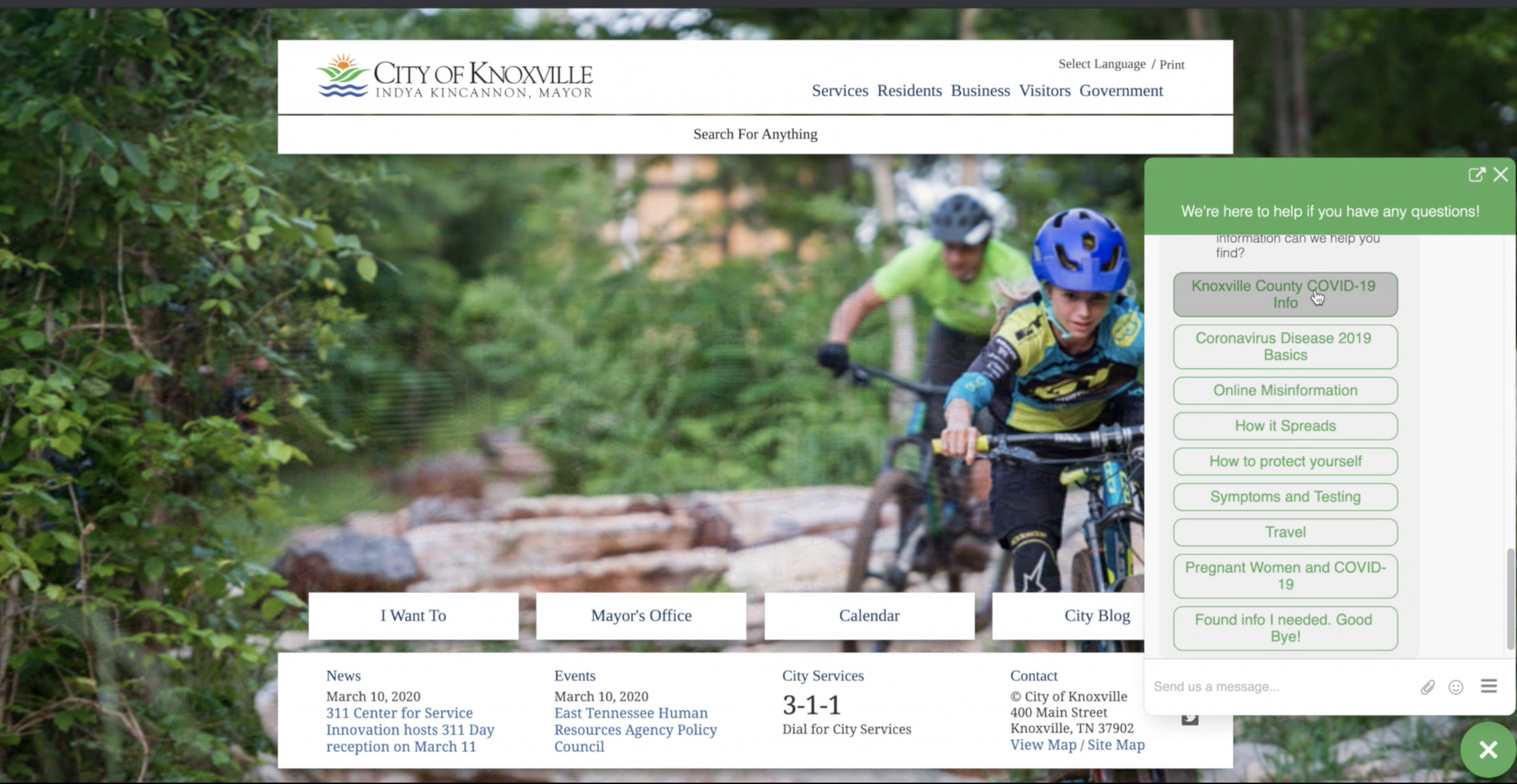
Successfully Implementing Messaging
COVID19 information is constantly being updated. Quiq’s messaging platform can be live on your site in a couple of days with just a few simple edits to your website. Your existing landlines can send and receive messages from SMS/text, web chat, and social channels. With minimum training, your staff can be up and running, helping students get the information they need.
Quiq is ready to work with you on offering modern digital channels that have proved more efficient and effective than phone calls and emails. Allow your faculty and staff to focus on delivering world-class education instead of fielding questions. Schedule time today to discuss messaging.
Retailers Are Leaving Money On The…Tablet and Smartphone
The 2019 holiday season saw Cyber Monday break ecommerce records with $9.4 billion coming from online sales. An impressive $3 billion of those sales occurred on a smartphone – double the prior year. Mobile rules consumers’ personal lives and how organizations engage with consumers via mobile is quickly evolving.
Mobile shopping has been clearly gaining ground year over year, but retailers are still “catching up” to consumer’s preferences. In a recent survey conducted by Sapio research titled “2020 Mobile Retail Trends”, retailers admit they have a lot of work to do.
Let’s take a brief look at the history of mobile shopping for insight into why this game of catch-up is afoot. Then, we’ll examine the mobile retail trends happening today which are shaping the future of retailer’s mobile shopping strategy.
The Evolution of M-Commerce or Mobile Shopping
Believe it or not, consumers have been buying things on their phones since 1997. Back then, purchases were limited to ringtones and services. No one called it M-commerce then, but that term now describes any monetary transaction completed using a mobile device. As years passed, transactions became more sophisticated, but the first tangible goods weren’t sold until 2003. Even then, the process required users to register their bank accounts online and reply “yes” to special offers sent to them through text messages.
Mobile shopping didn’t really get a boost until the first iPhones were released in 2007. Turns out, putting the internet into everyone’s pocket would change everything. According to data from Ericsson, data usage exploded at a staggering rate, while voice data clipped on at a steady pace over the years.

The accessibility and freedom that smart devices offer created a whole new generation of tech-savvy and informed buyers. At the same time, the number of new services, like streaming videos and music, shaped a new expectation that purchases should be available instantly.
Not only did consumers expect retailers to make products more available, but they expected any pre-sales service or post-sales support to be available too, especially with the ever-growing popularity of social channels like Facebook and Twitter adding to the digital places consumers expect to see their favorite retailers and brands. All of these changes took place at a staggering rate, leaving many retailers trying to discern where and how they should best invest their resources.
That brings us to today. The new era of mobile commerce requires retailers to have a presence on the digital channels their customers spend their time, including SMS/text, mobile web chat, and social channels. M-commerce has evolved into conversational commerce, and there are real costs to missing out on this new way of doing business.
The Cost of Missing Out on Conversational Commerce
According to comScore, mobile retailers are missing an opportunity to capitalize on the amount of time consumers spend on their phones, evidenced by the gap between share of minutes and dollars spent. Four of the top five reasons consumers cite for not-converting on a mobile site involve basic difficulties with usability.

If you’ve ever visited a website that isn’t optimized for mobile on your phone, you know how frustrating it can be. Tiny buttons and links serve as impossible touch targets, scrolling that never ends, and forms that are difficult to fill out on a tiny keyboard, create hassles and often result in abandonment.
The issues above are a source of friction for consumers. The more friction, the less likely customers are to convert. Busy, stressed out, and impatient consumers are not willing to wait for a slow page to load or spend time trying to figure out how to add products to their carts.
Contrast that to the new conversational commerce way of engagement:
- For example, let’s say you are shopping for some new decor on Pier 1’s website, so you send their customer service a text for a little help. Pier 1’s agent sends you a few options of artwork that may match your style by using rich messaging in order to better help you visualize your choices. You find artwork that you think would work over your couch and snap a picture of your room to view the artwork over your couch using augmented reality. Happy with the piece, the agent places it in your cart and you securely check out with just a few taps – all within the messaging conversation.
That’s a big difference from today, and it’s a difference that retailers can feel on their bottom line. According to research conducted by Sapio Research, 65% of respondents state that mobile technology has actually increased their revenue. For your customers, it means a more fluid experience. In fact, our clients have experienced double digit higher customer satisfaction scores with messaging versus traditional email and phone channels.
Trends Shaping Mobile Shopping
According to the “2020 Retail Mobile Trends Report”, the evolution of mobile shopping is clearly pointing retailers in the direction of being “mobile-first”. This goes way beyond making sure that your website has a responsive design. Although responsive design is important for a better experience across multiple screens, being mobile-first means just that – putting the mobile experience first.
In the 2020 Retail Mobile Trends Report, 37% of retailers have integrated mobile into their holistic customer experience. From browsing to buying, to engaging with a brand online and in-store, mobile is part and parcel to the planned and purposeful buying experience. You can download the full report from Sapio from the Quiq website.
The majority of respondents (54%) to Sapio’s survey admitted that they’re not fully prepared to meet consumer demands for mobile, and it shows. According to the latest conversion rate data by Smartinsights, approximately 4.14% of consumers convert when shopping on their desktop, while only 1.53% of shoppers convert on their mobile phone.
Seizing Mobile Retail Trends
Mobile is the future of retail and consumers will not tolerate the outdated retail processes and channels that existed before smartphones, like calling a 1-800 number and waiting on hold to place an order. If you’re like most retailers, you may be wondering what the fastest way to seize the opportunity of today’s mobile retail preference is. Luckily, there’s a way to leapfrog into this new era of conversational commerce by implementing messaging.
With Quiq’s messaging platform, you can enable your current landlines to send and receive messages across a wide portfolio of digital channels. Skip the app entirely. You can easily provide your customers with rich messaging experiences through Google Business Messaging and Apple Business Chat, allowing them to browse, shop, and complete secure transactions without leaving the messaging conversation. With Quiq’s conversational engagement platform, companies can easily orchestrate commerce and service conversations involving both bots and humans.
If you’re ready to dismiss the reservations around messaging and increase your mobile conversion rate, set up some time to discuss it with one of our messaging experts. We’re looking forward to helping you ride this wave of mobile retail trends to a more profitable future.
What is Digital Customer Service?
When defining digital customer service, it may be easier to say what it is rather than what it isn’t. In order to do that, let’s define the opposite of digital customer service as “traditional customer service.” Traditional customer service takes place over the phone or after waiting in line to speak to someone face-to-face. On the other hand, digital customer service means serving your customers across digital channels. These channels would include email, SMS / text messaging, live chat, Facebook, Twitter, WeChat, and more.
Digital or online service channels have exploded. Consumers love having a wide variety of ways to reach out to a company, because it means they can pick the channel that is most comfortable or accessible to them – versus being forced to make a phone call. It means companies can deliver a great experience, with less work, and that means a lot.
The asynchronous nature of digital service means that agents can handle multiple simultaneous conversations. Customers don’t expect an immediate answer, which gives agents the ability to address more than one inquiry at a time. It also gives customers the freedom to set the pace of the conversation.
Digital Customer Service Solutions Today
Digital channels that once were new and novel are now the norm, like email and Facebook. However, digital channels continue to expand, as well as the technologies that support them. For example, Apple and Google have taken plain text messaging and made it rich. Rich messaging allows for secure payments, scheduling appointments, and the ability to share more sophisticated content. Also, chatbots can be part of nearly every digital interaction and can be deployed as a great compliment to human interactions.
The ubiquity of mobile devices to research, browse, shop, and purchase products has created the need for more web-based service channels that offer assistance without requiring customers to find time to pick up the phone and call a company. Thus, we have seen the the increase of digital customer service solutions and the ability to assist your customers on their digital channel of choice.
Your customers expect a seamless, convenient, and easy digital experience whenever they engage with you. Whether they are looking for help while shopping on your website, trying to book an appointment in your mobile app, or contacting customer service through a Twitter direct message with a question about their order.
Digital customer service can go by other names such as digital customer experience, digital customer care, or digital customer support. Regardless of what you call it, the definition is the same – serving your customers across digital channels and platforms such as SMS/text, live chat, and social platforms like Facebook, Twitter, and WeChat.
Increased Demand for Digital Customer Service
There are four main reasons companies pursue a digital customer service strategy:
 Customer Preferences
Customer Preferences

Forrester’s executive report, The Digital Customer Experience Improvement Playbook, succinctly sums up the current state of affairs for customer service:
“Customers demand that their digital interactions with your brand be seamless and span devices; that they be able to engage with your brand whenever and wherever they’d like; and that every encounter meet their needs in the moment.”
Companies are adopting a digital-first approach to meet customers wherever they are. Customers demand their channel of choice, whatever that channel may be, to engage with a company. That’s why so many service and support leaders across all industries, in companies of every size, are offering digital channels like SMS, WeChat, and Facebook for customer service and support.
 Competition
Competition
As consumers seek companies that are easy to engage with, competition continues to offer more options. Customer service organizations are rapidly adopting digital channels and capabilities to meet customer needs and set them apart from their competition.
 Cost
Cost
Gartner estimates that live channels such as phone, chat, and email can cost an average of $8.01 per contact vs. $.1o to serve on digital channels. Service and support leaders who use these channels as their primary customer contact methods are under pressure to reduce the cost to serve customers.
 Scaling
Scaling
The 2019 holiday season saw mobile sales via smartphones break the $3 billion mark according to TechCrunch; up from the $1.5 billion spent on Cyber Monday a year prior. Scaling resources to meet increased demand, especially from consumers that instinctively reach for their mobile device to engage with companies throughout their entire purchase, is another reason digital customer service is on the rise.
Leaders facing these challenges turned their focus to improving how, when, and where they serve their customers across digital channels with the intent of putting the customer at the center of it all.
And by doing so, they have impacted their business by:
- Engaging with customers they normally would not have reached
- Differentiating themselves with easy and convenient access for customers
- Reducing costs with the shift from phone calls to digital
- Increasing customer satisfaction with much preferred digital channels
Digital Customer Service – Who’s Doing It Right
A quick glance through the client section of our blog will give you an idea of just some of the diversity we see in industries and use cases. But let’s take a closer look to see what a few of these companies are doing and the results they’re achieving,
Increased Engagement
Overstock.com has seen a 98% open rate when communicating with people through texts. As of today, over 15% of all contacts that used to come in via the phone are now coming into the contact center via text.
Aspira, helps people book and manage outdoor recreation reservations. They receive about 300 to 400 texts a day. The ability to text for help is particularly helpful since their clientele is usually in transit to, or already on-site, at a campground or park facility.
Higher Customer Satisfaction
The Laundress has been able to offer a more personalized, “high-touch” experience for the customers of the high-end brand of soaps, detergents, and cleaning supplies. Since implementing Quiq, the retailer handles everything from questions about scents and order status to product recommendations all through text.
Reduced Costs
Outdoor gear and apparel retailer, evo, has successfully reduced their volume of phone calls by implementing Quiq Messaging and chat. Since using the Quiq platform, average call volume has dropped from 70% to 50% of total contact volume.
Optimized Resources
Tailored Brands, known for men’s suits and outstanding customer service, added text messaging to their arsenal of digital channels. Text messaging enables agents to handle 5 text conversations at a time and upwards of 8 during peak demand.
The First Step In Your Digital Customer Service Journey
Let Quiq help you navigate the possibilities and potential of digital channels like SMS / text messaging, rich messaging, web chat, Facebook, and more.
Quiq is an experienced partner who delivers consistently jaw-dropping customer experiences across SMS/text messaging, rich messaging, web chat, and social channels. Quiq’s Conversational Engagement Platform, easily orchestrates commerce and service conversations involving both bots and humans. Let’s connect to better understand your business priorities and objectives so we help you make an impact with digital customer service.

